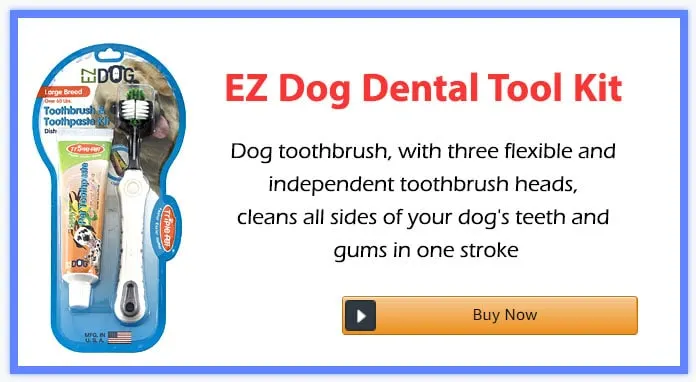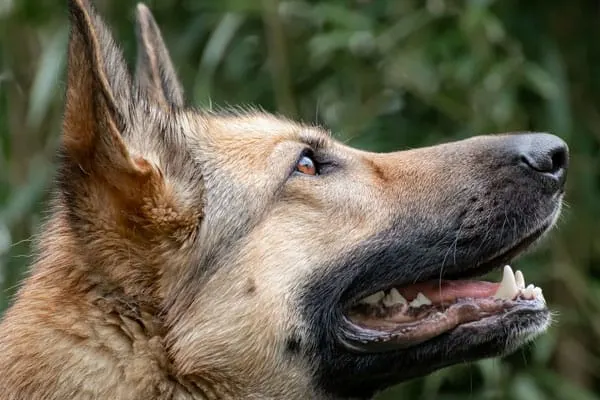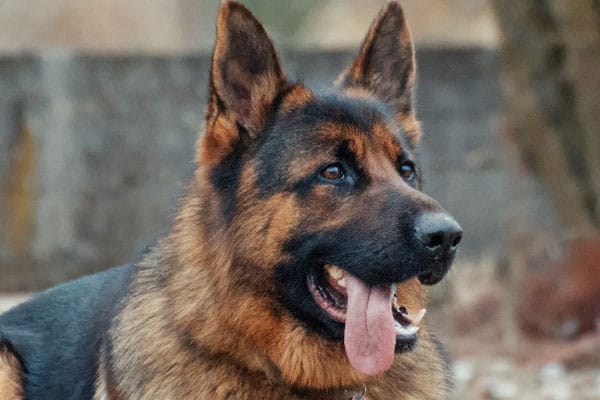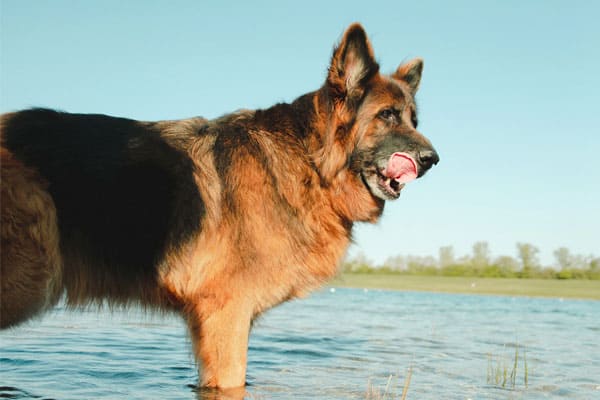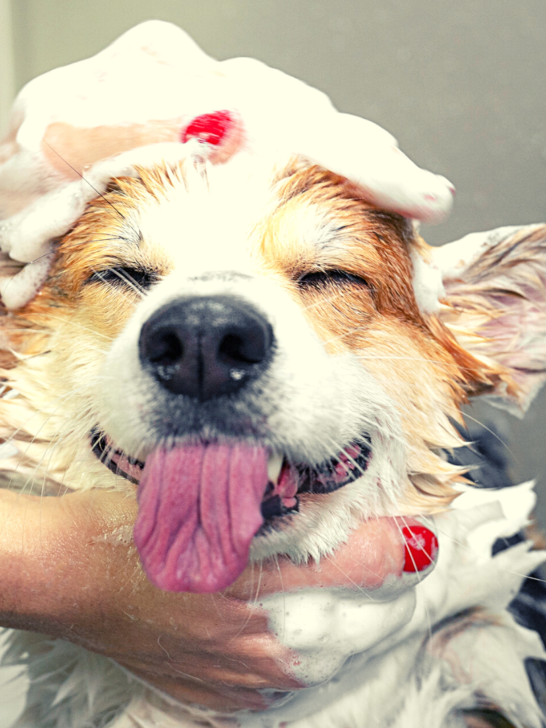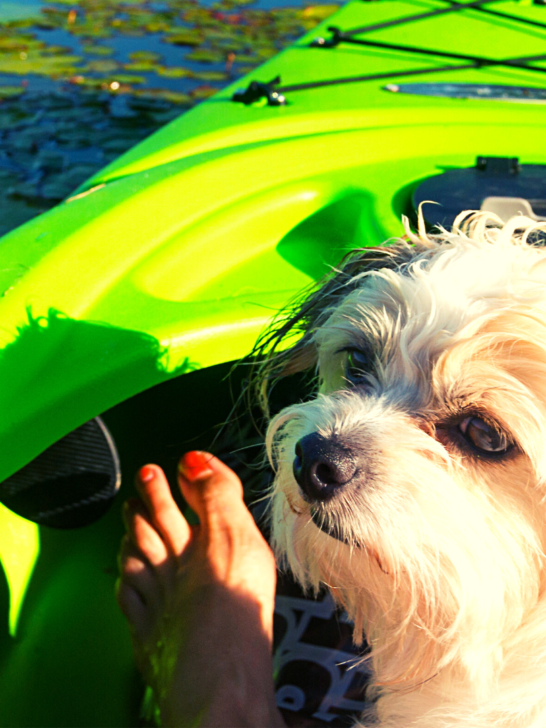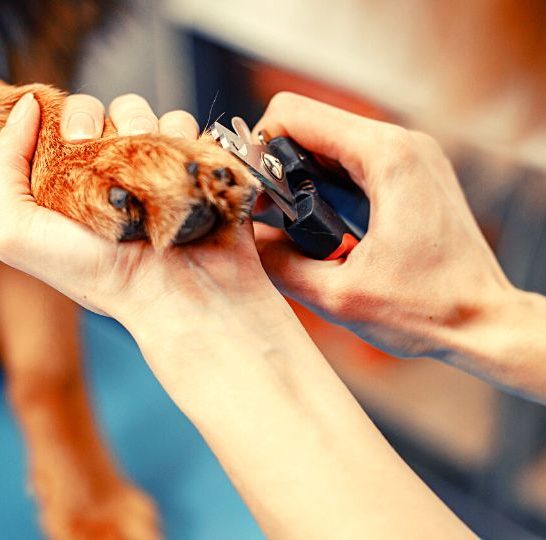6 Best Dog Toothbrushes and Toothpastes For German Shepherds
It’s an unfortunate fact that many dog owners do not brush their dog’s teeth. Proper oral hygiene is just as important for them as it is for us, so you need to do this from time to time.
Admittedly, most people don’t have time to do this every day, but once a week is a lot better than never.
If you are one of the many dog owners who do not regularly brush your dog’s teeth, don’t feel too bad: The majority of dog owners are in the same boat as you.
However, as of today, we are going to help you jump out of that boat and swim to the glorious island of dental health. That might be a little bit cheesy, but the metaphor fits.
Let’s start by looking at some of the best dog toothbrushes and toothpaste for German Shepherd that we could find online.
After that, we will cover some general information about canine oral hygiene and the exact procedures by which you should brush your dog’s teeth.
IN A HURRY? HERE’S OUR TOP PICKS…
 Vet’s Best Enzymatic Dog ToothpasteBest Overall Product |  Best Budget Product EZ Dog Dental Tool Kit |  Runner-Up Emmi-Pet Electric Toothbrush Kit For Pets Pros | |
Summary | Although we have some excellent choices on this list, we felt that this was the best all-around option for German Shepherd owners. | This one is very similar to our top product, except that it is significantly cheaper. Thus, it was a natural choice for the “best budget product.” | This is the only electric toothbrush on our list, as these are not commonly used for dogs. |
Pros | Very affordable | Easier to hit the right angles | Much easier on the dog owner |
Cons | May not reach the gums as effectively | Not quite as durable | Doesn’t force you to develop good technique |
Best Overall Product: Vet’s Best Enzymatic Dog Toothpaste & Toothbrush
Pros
- Very affordable
- No gimmicks- simple effectiveness
- Toothpaste is made for maximum enzymatic cleaning power
- Multi-brush makes it easier to hit all the right angles
- Made from all-natural and safe ingredients
Cons
- May not reach the gums as effectively
- Toothpaste isn’t meat-flavored
- SOOTHING AND EFFECTIVE - Vet’s Best Enzymatic Dental Gel Toothpaste is a veterinarian formulated soothing and effective mix of aloe, neem oil, grapefruit seed extract, baking soda, and enzymes
Although we have some excellent choices on this list, we felt that this was the best all-around option for German Shepherd owners.
The best thing about it would have to be the three-headed brush, which makes it much easier to hit the right angles when brushing your dog’s teeth.
As we will discuss in more detail later, you should always brush your dog’s teeth at a 45-degree angle. With this brush, you already have two extra brushes that are set at those exact angles.
The handle is pretty comfortable and provides enough grip to do the job. We like the fact that it isn’t rounded, as the edges make it easier to hold onto this thing if it should get hung.
The bristles are strong but soft, and that’s just what you want for a product of this type. We don’t see any fancy gimmicks here, whether in the brush or the toothpaste.
Thus, when you combine that factor with its low price, this becomes an excellent way to get it done.
We do worry that this tri-headed design might not be able to reach all the way to the dog’s gums. For larger German Shepherds, you will still have to turn the brush just a little bit in order to hit the correct angle.
Still, this is a minor issue because it’s still easier to use than a single-head brush. As for the toothpaste itself, we are glad to see that it’s made from strong but natural enzymes.
Most of these enzymes are plant-derived, but we would have like to see them include something meaty in the ingredients.
Best Budget Product: EZ Dog Dental Tool Kit
Pros
- Easier to hit the right angles
- Provides a slightly stronger cleaning action
- Dishwasher-safe = easy to clean
- Excellent grip
- Toothpaste gives minty fresh breath
Cons
- Not quite as durable
- Middle bristles are a little too stiff
This one is very similar to our top product, except that it is significantly cheaper. Thus, it was a natural choice for the “best budget product.”
If you are really low on cash, and you need a good toothbrush/toothpaste set for your dog, this is a good way to go. It has that nice three-headed brush that allows you to hit the right angles with less effort.
One thing we can’t help but notice is the fact that the middle bristles are different from those on the left and right. They are thicker and stiffer, which is both a good thing and a bad thing.
On the one hand, they do provide a stronger cleaning action. Using this brush, you should be able to remove even the most stubborn bits of debris.
However, it also means that this brush could be a little uncomfortable for the dog. Thus, we would say that you ought to discontinue using this if your dog shows signs of discomfort.
We would recommend this one for dogs that are already used to having their teeth brushed, for obvious reasons.
The toothpaste is an all-natural formulation, but that doesn’t tell us a whole lot. The quantity isn’t great, but you can’t expect better at that price.
However, it does have a minty-fresh aroma that will improve your dog’s breath.
The Runner-Up: Emmi-Pet Electric Toothbrush Kit For Pets
Pros
- Much easier on the dog owner
- Uses high-tech methods for deeper cleaning
- No noise or vibration to startle your dog
- Comes with two types of bristle heads
- Comes with a large bottle of toothpaste
Cons
- Doesn’t force you to develop good technique
- DEEP CLEANS with patented, gentle 100% Ultrasound wave technology and millions of nano-cleaning bubbles. Cleans even inside tiniest gaps and crevices that are hard to reach by ordinary toothbrushes.
This is the only electric toothbrush on our list, as these are not commonly used for dogs. The noise and vibration of most electric toothbrushes make them impractical for use on pets, but this is an exception.
This device uses ultrasound waves to provide the abrasive action that is necessary for cleaning.
We were surprised that there was no vibration or noise, other than a very low hum. It certainly wouldn’t be enough to startle most German Shepherds.
The product claims that its sound-based method of cleaning is better than normal brushing and that it can reach areas that a brush cannot.
We aren’t sure if this is true, but it should surely make the daily brushing into an easier job. It has two types of bristle heads, giving you two options (in case your dog doesn’t like one).
We don’t see much information about the toothpaste, but at least the quantity is sufficient.
In the end, we can only see two downsides with this product. First of all, it is really expensive for a product of this type.
Relatively few people could afford to spend this much on a pet toothbrush, and that is the only thing that kept this product from getting our top spot.
Secondly, a product like this could prevent you from developing the right brushing technique, since it basically does all the work for you.
Honorable Mention: Arm & Hammer Clinical Care Health Kit for Dogs
Pros
- Trusted, traditional option
- Baking soda toothpaste is highly effective
- Toothpaste is both minty and beefy
- Three different brushes to choose from
- Cheapest on our list
Cons
- Doesn’t look that sturdy
- Not a lot of toothpaste
- PROMOTES HEALTHY GUMS — Dog dental kit is gentle yet effective in reducing tartar buildup, eliminating dogs bad breath, and whitening and brightening your dogs teeth
This is the cheapest option on our list, and it offers quite a bit. You might be wondering why we didn’t choose this one as the “best budget product.”
Basically, the EZ Dog won that prize over this one because it seems a little sturdier, has a triple head and is only slightly more expensive. That being said, Arm & Hammer made an excellent product here.
This is a double-headed brush, complete with a finger brush for good measure. The finger brush has short rubber bristles that are great for the rinsing step (see the information section below).
As you might expect, the toothpaste contains baking soda, and that is a good thing. Baking soda is chemically neutral, non-toxic, and does a great job of removing filth from teeth.
It’s one of the few components of human toothpaste that can also be used for dogs.
Speaking of the toothpaste, it is both minty and beefy. That would be disgusting for you or me, but dogs seem to like it pretty well. It freshens their breath and gives that nice meaty taste that all dogs love.
However, we do have a few small complaints. The brush itself is thin and doesn’t seem too strong, and the quantity of toothpaste is pretty small. Still, it’s a good deal for the money.
Alternative 1: BarkBox Bright Toothpaste & Toothbrush Chews Kit
Pros
- Provides a great low-effort option
- Can be used as a reward
- Requires no training
- Disposable product = no need for cleaning
Cons
- Can get expensive over time
- Not as good as a real brushing
This one is a little different from the others, simply because is technically classified as a dental chew. However, in practice, this is basically an edible toothbrush.
You just put the toothpaste along one recessed side of the “toothbrush,” and give it to the dog.
They chew it like a treat and its abrasive action (combined with the enzymes in the toothpaste) cleans their teeth.
This is a good low-effort option for those days when you don’t have time for a full brushing, but it will never be as good as full brushing, either.
Still, it makes a great reward when training your dog, because it fulfills two purposes at once. And, of course, there is the fact that no dog needs to be trained to chew on something tasty.
It can take a while to teach your dog to tolerate a full brushing, but this is a good option that can be employed until then (only as a temporary measure, of course).
As we said, this can never take the place of the real thing, even if it does make a decent substitute. Apart from that, we question whether it is okay for dogs to eat that much toothpaste.
It may not be toxic, but many harmless things can become problematic in large amounts. Besides that, a disposable product has an upside and a downside.
On the one hand, you don’t have to worry about cleaning a toothbrush. On the other hand, you will end up spending more money over time.
Alternative 2: Nylabone Advanced Oral Care Dental Kit
Pros
- Very cheap
- Feels more like a human toothbrush
- A finger brush is high-quality
- Bristles are very soft
Cons
- Can be a little hard to get the right angle
- Not all that sturdy
- Vet-recommended dog dental kit naturally promotes healthy teeth and gums
- Adult dog toothbrush has an angled neck for better reach
- 2.5 ounce bottle features Denta-C thats scientifically proven to help reduce plaque that harbors bacteria
- Dog finger brush gently slips over finger to remove plaque and food debris
- Dog oral kit made in the USA
- Dog toothpaste contains natural peanut flavor pups love
This is an alternate product because it has a different feel when compared to the rest. And so, it takes a little getting used to this one.
Still, it’s a cheap and effective solution for your dog’s teeth-cleaning needs.
We like the fact that it includes a finger brush of high quality, whereas most of those finger brushes are disposable and not very well-made.
The main advantage of this brush (for some people, anyway) is the fact that it feels more like a human toothbrush. It is angled in a way that is a little different, but the difference is a slight one.
The main brush has two types of bristles, but both of them are very soft. The mix of standard and rubber bristles is really good because it provides two different cleaning actions.
The rubber bristles do great for the surface, while the softer ones go between the crevices and get the smaller bits of debris.
This one doesn’t include very much toothpaste, and we also don’t like how the brush is thinnest at the point where the head meets the handle.
This is exactly the spot where it needs to be strongest, so this one suffers in the durability department.
A Quick Guide To Canine Dental Anatomy
Although you don’t need to have a detailed knowledge of canine dentistry, it does pay to know a little bit about the different types of teeth that your dog will have.
The teeth of dogs are fundamentally different from ours, and you can’t really judge their health in the same way.
Like ourselves, dogs have two sets of teeth: One for childhood and one for adolescence/adulthood.
The first set of teeth comes in at 6-8 weeks of age, and are replaced by 42 adult teeth when the dog is 6-7 months old. As you can see, they don’t keep their baby teeth nearly as long as humans do.
Dogs have four types of teeth:
- Incisors
- Canines
- Premolars
- Molars
You probably know that the canines are the long teeth in the front. These are primarily used for ripping and tearing and are the dog’s primary defensive weapons.
The incisors are the thin, scraper-like teeth in the front, located between each set of canines. These are used for nipping and for shredding small pieces of food.
Those teeth on the sides are called premolars, and they are used for both shearing and crushing.
Finally, you have the big teeth in the back, which are molars. These are used to break and crush harder food items, as well as anything they wish to chew.
If you’ve ever wondered how a dog can crush a bone into tiny pieces with so little effort, these big teeth are the reason.
Once in a while, you will see a dog that has an extra canine tooth. This extra tooth (or teeth) will usually be smaller than the others and will be more hooked and sharp.
This is because it is a puppy tooth that has been retained.
Normally, the adult tooth pushes the puppy tooth out completely, leaving nothing behind. However, there are times when a root is left behind, and this is the result.
Doctors will usually recommend surgical extraction, but it may not be necessary.
How To Brush A German Shepherd’s Teeth
If you’ve never brushed a dog’s teeth before, it wouldn’t hurt to go over some basic technique. In fact, we’re going to get very in-depth with these instructions because the results are important.
We want your dog to have the best oral health possible, and that can only happen if you know how to make it happen. Let’s go over the whole procedure.
Step 1: Getting The Right Stuff
We have already talked about the different kinds of dog-friendly toothbrushes out there, and we have covered information about toothpaste as well.
There is no need to rehash all of that, so you can refer to the product reviews for a better idea of how to choose these things.
In case you are wondering, human toothpaste is not suitable for dogs. It contains ingredients that are dangerous to dogs (particularly the fluoride).
Human toothbrushes, however, can be used for a dog. Since we are talking about a German Shepherd here, it would be wise to get a toothbrush that is on the larger end of the size spectrum.
Otherwise, you might end up having to reach all the way into your dog’s mouth, and that makes everything harder.
Step 2: Choose The Right Time
Your dog probably won’t understand what you are doing, and you need to keep that in mind.
It will require trust for your dog to let you brush their teeth, so don’t just assume that they will be okay with it anytime.
You need to choose a time when the dog is calm and lazy, probably in the evening when they have already expended most of their energy.
You should also choose a time in which there isn’t a whole lot of commotion going on. Preferably, it should just be you and your dog in a quiet room.
Step 3: Prepare Some Lighting
This might seem unnecessary, and it is true that you don’t have to do this. However, there is a reason why your dentist’s table has a large light.
It is much easier to clean your dog’s teeth (and to do a good job) when you have adequate lighting. This doesn’t require a big, blaring light like the one your dentist probably uses, however.
A simple lamp should be enough to give you adequate lighting for this task. Just make sure it’s one that can be pointed in one direction.
A moveable head is nice, so a common desk lamp fits the bill very nicely. Not only will this tell you which teeth need the most attention, but it will also tell you when you are done.
Step 4: Make The Dog Comfortable
You want to make this whole thing as easy for the dog as possible, so you should go through a pre-brushing routine before you start.
Dogs understand this kind of thing, as they are naturally creatures of habit.
You should start by commanding them to sit, and then giving them praise and/or a reward for complying.
Then, make them stay in that position for at least ten seconds before praising/rewarding them again. A sitting position works well for brushing time, so you can start by getting them used to that.
After this, you can start petting the dog and handling their teeth and gums.
If this seems disgusting, remember that their mouths are actually cleaner than ours (unless they have just consumed something filthy, of course!).
Either way, you are trying to get them acclimated to the feeling of someone handling their teeth and gums, something that they otherwise might not tolerate.
Most experts say that it’s good to avoid standing over your dog when they are in this position. It can be a little intimidating, so you should get down on one knee.
This will put you at their level and allow them to look you directly in the eye.
You should also avoid holding the dog forcefully in place, as this may frighten them and induce them to try and run.
If anything, you might simply place a reassuring hand on the dog’s lower back without applying any real pressure. Most of the time, that is enough to keep the dog from bolting or squirming.
Step 5: Troubleshooting Compliance
If your dog goes along with all of this so far and does not try to escape or resist in any way, you can safely skip this step. While you’re at it, you should be thankful that you have such an obedient dog.
However, a lot of people will find that their dogs don’t want to tolerate this process at first. It is perfectly natural for dogs to be protective of their teeth.
After all, these are a dog’s primary tools (since they lack opposable thumbs).
If you are dealing with a difficult case, you might have to use an incremental approach. Start by touching the mouth and gums, being very gentle, and not forcing the dog in any way.
Get them used to the idea that this is normal and not harmful. If they growl at you, stop and reassure them in whatever way you can. When they comply, praise/reward them.
The important thing is to get them acclimated to this first stage before moving on to the next.
After the dog has learned to tolerate someone’s fingers in their mouth, the next step is: get them to tolerate the brush.
A foreign object like this is a little more intrusive than their master’s finger, so don’t try to rush this one.
Start by touching the toothbrush gently to their teeth and gums. You are basically showing them that it won’t hurt them, and normalizing the situation for them as well.
As before, stop and reassure the dog (if necessary) and reward/praise the dog when compliance is achieved.
The next step is to get them accustomed to the toothpaste itself. Most canine toothpaste is flavored with things that dogs like, such as poultry or bacon.
That should help quite a bit, but dogs will still often find toothpaste to be a little weird at first.
The main thing is to make them understand that they cannot eat the toothpaste. It won’t hurt them, as dog toothpaste is designed to be edible, but it is a big waste.
To get them used to the toothpaste, just put a little bit of it in their mouth and/or across their teeth.
If they like the flavor, they will probably start showing interest in the bottle or tube from which the toothpaste comes. That is a good indication that your job is done.
After all of this is done, your dog will be used to all the basic steps of tooth-brushing without ever having had it done.
Thus, when you move to the next step and begin the actual brushing, things will be a lot easier.
Step 6: Brushing Technique
After all that preparatory work, you are probably ready to get down to business. To do that, begin by lifting up your dog’s lips in the front. This is necessary in order to see what you are doing.
Besides, those lips will get in the way of your brushing action. You don’t want to be too rough here, and you should never attempt to clamp those lips open or anything like that.
Put some toothpaste on the brush and start gently brushing the large canine teeth in the front. These teeth stick out from the rest, so it is better to get them first.
Use a gentle, circular motion to remove all that nasty tartar and plaque. Don’t try to wash the toothpaste away when you’re done: Just leave it and move on to the smaller teeth.
Now go to one side and lift up their lips to make room for the brush.
Hold the brush at a 45-degree angle (meaning that the brush is held diagonally in relation to the line of the teeth) and start brushing in a circular motion.
Use small circles, somewhat as you would use for your teeth. However, you don’t need to use a brisk and vigorous stroke here because dog toothpaste works a little differently.
Human toothpaste uses fluoride and other things as a surfactant, which is why you use that quick-stroke action when brushing your teeth.
However, dog toothpaste cannot use these things, as they are toxic to dogs.
For the record, large amounts of fluoride are equally toxic to human beings, but we have enough sense to avoid swallowing the stuff.
Dog toothpaste works through the use of special enzymes that break down the tartar and plaque.
This causes them to release their hold on your dog’s teeth, and they can then be brushed and rinsed away with ease.
For this reason, you need to allow most dog toothpaste to sit on your dog’s teeth for a few minutes. This gives it plenty of time to act on the offending debris.
When you are done, move on to the next side and clean it in the same way. And, of course, the front teeth are next.
You can just turn your brush to the side and easily get these teeth in the same way that you got the other ones. Just make sure you maintain that good 45-degree angle while stroking, though.
This angle is preferred because it allows you to massage the gums while putting the bristles all the way through the gaps between their teeth.
In a square(ish) space, a diagonal line will cross with the shortest distance, so some of this just comes down to simple physics.
You should also know that the outsides of the teeth are a bigger priority than the insides (by a long shot).
Dogs have a course tongue that they use to clean the insides of their teeth, so the majority of the tartar and plaque will accumulate on the outsides.
If your dog doesn’t let you brush the insides of their teeth, it’s probably no big deal.
Step 7: Rinse And Reward
As you might guess, this is the simplest step. At this point, the toothpaste should have been sitting on your dog’s gums for several minutes.
5 minutes is plenty, and you definitely don’t need to wait for more than 10. So, now it’s time for one final brushing.
This is a light one, so you don’t need to worry about lifting the lips or holding their head in place. You can just put the brush in their mouth and start stroking gently with a circular motion as before.
You don’t have to put any real effort into this part, as it’s just a light scrubbing. By this point, your dog should be calm and compliant.
They might be enjoying the flavor of the toothpaste, which is perfectly fine. Scrub the outsides of their teeth on both sides, and pay special attention to those big canines.
If possible, get the insides of their teeth a little bit, too.
Now, we come to the rinsing stage. When humans brush our teeth, we just take a mouthful of water, slosh it around, and then spit it out.
Dogs obviously aren’t going to do this, and they probably aren’t physically capable of such. Instead, you can take a plastic water bottle (20-ounce size will do) and punch 3-5 little holes in the lid.
Fill the bottle with water, and you’ve got an improvised squirting device.
This bottle will squirt a very gentle stream of water when you squeeze it, and that should not alarm the dog. It’s much gentler than your shower head, and that’s why it is preferred.
You don’t need to give them a really thorough rinsing, just enough so that you can no longer see the toothpaste residue on their teeth.
When you’re done, finish the rinsing process by offering them a bowl of water. Encourage them to drink as much as they want. Finally, when all is done, you should praise and reward the dog heartily.
If they are still getting used to the process, this might be a good time to feed them. They will then come to associate brushing with feeding time, and that can only be helpful to you.
Incorporating The Use Of Dental Dog Chews
Brushing your dog’s teeth is a very important step that you can take to ensure that their teeth stay healthy well into old age.
However, there is more than one way to skin a cat, and there is also more than one way to help a dog. On days when you just don’t have time to brush their teeth, you can go ahead and give them a dental chew.
You’ve probably seen ads for dog treats that promise better dental health for your dog, simply as a result of using their product.
Like many commercials, these are an example of “exaggerated truth.” It is true that chewing these dental treats will have a cleaning effect on the teeth of a dog.
It’s also true that regular use is likely to result in better dental health.
However, these ads will usually exaggerate the benefits of their specific product over those of others, and that is where the mistruth can be found.
The truth is that all chewing is good for a dog’s teeth. In fact, that’s one of the reasons that dogs naturally love to chew things.
They cannot pick up a brush and clean their teeth, so wild canines rely on this method alone.
You may have noticed that dogs gravitate towards chewing on things that have a rough texture. If you want to understand a little bit better, just imagine that you’ve got something stuck in your teeth.
Now imagine that you have no thumbs and that chewing a rough object is the only way you can dislodge this annoying bit.
We already mentioned this study, which showed how much different texture can make. By increasing the size of dog kibble, they were able to reduce the total amount of tartar and plaque on the dog’s teeth.
To rehash, a 50% increase in particle size resulted in a 42% decrease in plaque/tartar. It is worth mentioning this again because it really shows how effective this method of cleaning can be.
So, how do you work this into your dog’s oral hygiene routine?
Well, apart from using it as an occasional “cheat,” you can also use it to keep your dog from accumulating a lot of tartar and plaque in the first place.
This will make your brushing sessions both easier and shorter, saving you time and saving your dog some aggravation.
Here’s the idea: Just give them a dental chew after every meal so that the food residues can be effectively removed before they turn into tartar and plaque, which will later turn into serious decay.
Diagnosing Dental Problems
In all fairness, we should tell you that we are not veterinary dentists. Chances are, you aren’t one of these either.
However, there are many common signs that can tell us when our dogs have a serious dental problem.
Some things, like rot and cavities, are pretty obvious. Some other things are a little subtle.
Let’s go over a short guide to these signs, with the understanding that you should consult your veterinary dentist before taking any specific action.
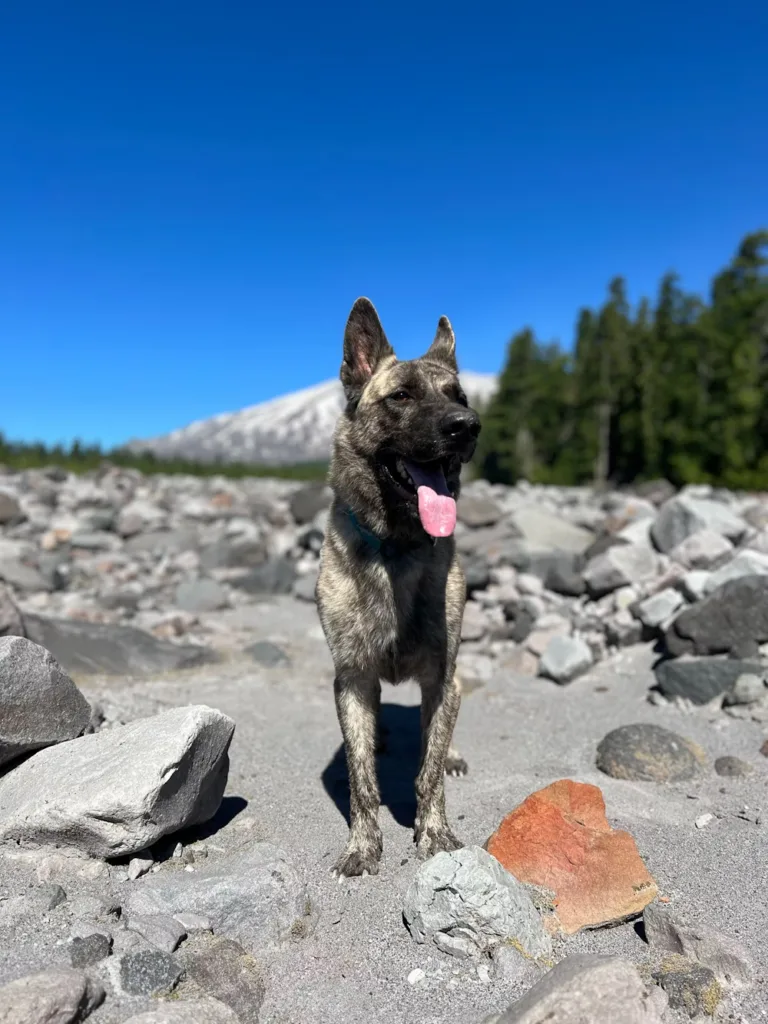
Bad breath is one potential indicator of trouble, but only if it is very consistent. If little Fido has bad breath for one day, it’s probably because he ate something filthy.
And, of course, let’s not forget that dogs spend large amounts of time licking their private areas, which doesn’t exactly result in a minty-fresh breath.
However, if that smell persists, you might be smelling the decay of their teeth.
Speaking of which, the nature of the smell will also help you to identify whether or not it is a dental problem.
If it is the result of tooth decay, it will smell like rot-in other words, like a dead and festering corpse.
Once you open the mouth, you can start your inspection by looking for any broken or missing teeth. These will be pretty obvious, of course.
The coloration of your dog’s teeth is also important. You can’t always expect these teeth to be bone-white, as that isn’t natural for most dogs.
However, any black/brown spots on those teeth are probably indicators of decay. Swelling and bleeding are also obvious signs that you need to call the doggy dentist immediately.
You can also tell certain things by watching the way your dog eats.
If your dog normally eats with enthusiasm but has recently taken to “picking” at their food and eating slowly, that can indicate a problem.
They could be eating slowly because they are in pain. Anyone who has ever tried to eat with a toothache (which would be most of us) can sympathize with this plight.
A dog who is experiencing pain while eating may also drool a lot more than usual, and may uncomfortably drop food from their mouth.
Finally, we come to the gums. The coloration of your dog’s gums can be an important indicator of health or disease. In puppies, you can check for parvovirus in this way.
Excessively white gums will often indicate this problem, which is so lethal and common in pups.
Pale pink or white gums will also indicate anemia and/or blood loss. Even for adult dogs, this can be used as an indicator of oral health.
Your dog’s gums should be a deep, healthy bubblegum pink, and they may have splotches of purple.
They should not be sticky or dry, and should not have any blood, tumors, or growths. Blue gums indicate the presence of cyanosis, meaning that their blood is not getting enough oxygen.
Final Thoughts
In the end, we should tell you that any toothbrush is better than none at all.
Even though we have spent a lot of time talking about the differences between them, those differences really aren’t that large when it comes down to practical matters.
Any of these brushes would be good enough to do the job, and all of them would be large enough for any German Shepherd.
As we already said, you can even use a toothbrush designed for humans if you so desire. Still, we hope that we have given you all the knowledge that you need and that you have enjoyed reading our work.














